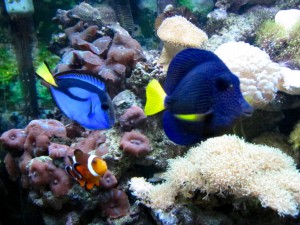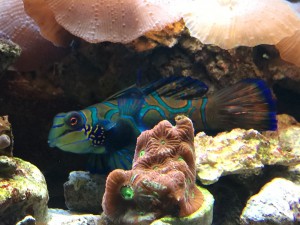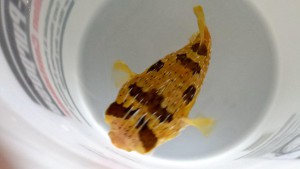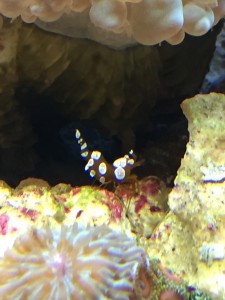
Reef Tank with special guests . .a beautiful Purple Tang, his side kick the Hippo Tang, and a saltwater staple . .the friendly Clownfish!
Bio-load :
Every aquarium has a maximum number of fish that its system can sustain. Bio-load is term used for fish waste. A high bio-load can also increase algae growth due to increased nitrate production. As a general rule, it’s recommended ONE inch of fish, per ONE gallon of water. For larger fish, it can also be said; ONE inch per THREE gallons of water. For Saltwater Aquariums, it is recommended ONE inch per TEN gallons, and for larger fish; FIFTEEN gallons.
Water Temperature :
| Freshwater | 75 – 80 |
| Saltwater | 76 – 80 |
| Reef | 76 – 80 |
| Goldfish / Koi | 68 – 74 |
Water Levels :
| Freshwater | Saltwater | Reef | |||||||||||||||||||||||||||||||||
|
|||||||||||||||||||||||||||||||||||
Acclimation of your fish :
The Fish Guy fully quarantines all of our Fish and Corals for a minimum of 2 weeks to ensure & maintain the health of your existing Fish.
You should always know the pH, water temperature, and salinity (if applicable) when acclimating new fish. If we bring Fish to your Aquarium or Pond – we will take care of all of that for you.

Blue/Green Mandarin Fish

Porcupine Pufferfish
Here are basic guidelines to follow when acclimating new fish:
Float the plastic bags in your Aquarium or Pond for about 15-20 minutes – this allows water temperature to equalize. Next begin adding water to the bag about every 15 minutes.
Depending upon the water parameters (pH and/or salinity) will dictate how long you need to acclimate your fish.
As long as the pH isn’t too far off one another, acclimating Freshwater fish for about an Hour should suffice.
If you are acclimating Saltwater Fish, you will need to know the salinity of the tank and the salinity the new fish is currently in – acclimation will take longer.
When acclimating invertebrates you need to take extra precaution in the acclimation process, as they are more sensitive to change.
Once levels are compatible and its time to add your new fish to your Aquarium or Pond, we always recommend not adding the water from the fish bag into your existing tank or pond. Remove fish using a net and/or bucket so you avoid adding potentially harmful water to your aquarium or pond. Remember even in a healthy environment, there can always be parasites and bacteria present.
The purpose of adding water slowly, is to adjust your fish to the pH, hardness and/or salinity of your tank. Rapid pH changes can severely affect otherwise healthy fish. As fish become accustomed to their new surrounding their defenses are down and stress level is elevated. This is an opportune time for stress related diseases to come out. If you purchase a fish through The Fish Guy – we fully quarantine our Fish and Corals.
If you should have any questions while acclimating a Fish, please don’t hesitate to call us . . it’s always better to be safe than sorry!

Itty Bitty Sexy Shrimp . .
Feeding your Livestock :
We recommend that you feed your fish smaller portions twice daily. A portion should consist of what your fish can consume in a 2-3 minute period. There should not be any excess food that gets sucked into the filter, or lay uneaten in the gravel. Any uneaten food should be removed. If you need to do this frequently, chances are you’re overfeeding, or feeding an improper diet.
Overfeeding creates an increase in ammonia, which leads to a spike in nitrates. Having uneaten food, dead plant leaves, bacteria, etc. left in your aquarium will also lead to a spike in phosphates. An elevated nitrate and phosphate level in your aquarium are the two main reasons for algae growth. Make sure you fish are “awake” when feeding takes place. Don’t feed them when you first put the lights on, or are ready to shut them off!!!
Fish can also go 1-2 days without being fed, if necessary. Adding an Auto Feeder can make feeding easier, especially in an office setting, or during vacations. Remember it’s also a great idea to feed your livestock a variety of foods. There are numerous choices which range from frozen, freeze dried, flake, pellet, etc.
Our aquarium technicians can provide you with the recommended types of food for your inhabitants. Auto Feeders, as well as a variety of foods are readily available for drop off!!
Fish Ailments: (Contact us right away if you have a sick fish – (516) 937-FISH)
Your fish can become sick, even when proper routine maintenance is performed. Observing the general health of your fish is very important!!! Early detection is key to prevent the spread of disease to other inhabitants in your aquarium. Some of the following fish ailments are commonly found in aquariums, and are treatable if caught early enough!!!
Mouth Rot:
Cotton-like growths around the mouth, may be bacterial or fungal infection, and will need to be medicated.
Rapid gill movement:
Can be caused by a lack of oxygen, a high nitrite level, a parasite or bacterial infection. Needs to be treated.
White Spots:
White spots like sugar grains located on skin and gills are signs of a parasite infection. Needs to be medicated, and if left untreated it will quickly spread to all the other inhabitants of your aquarium.
Fungus:
Cotton-like growths due to infection a of the skin which had been damaged. Needs to be treated.
Fin Rot:
Ragged edges to the fins which may also be red and sore is a bacterial infection known as fin rot. Needs to be treated, to stop it from spreading to the rest of the body.

